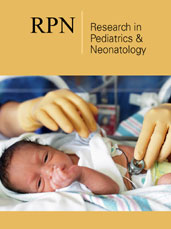The Relationship of Blood Prolactin, Cortisol and Thyroid Hormones in Prematural Newborns with Respiratory Distress Syndrome by Baris Yilmaz* in

Abstract
RDS
is one of the leading causes of morbidity and mortality in preterm infants. It
is well known that the main reason for RDS development is the deficiency of
pulmonary surfactant. Various endogenous hormones such as prolactin, cortisol,
testosterone, estradiol, estrone, thyroxine, and triiodothyronine play a major
role in fetal lung maturation. Neonates with low birth weights and low
gestational age are reported to have a higher risk of developing RDS than
average. Several studies which investigated the relationship between thyroid
hormones and RDS had shown that infants with RDS have lower free T4 (fT4) and
total (tT4) serum levels than
infants without RDS although both groups had similar gestational ages and birth
weights. Serum prolactin level of neonates increases proportionally with their
gestational ages and their birth weights.
Numerous
studies have been shown infants who have lower serum prolactin levels have an
increased risk of developing RDS, therefore prolactin might be an important
factor in fetal lung maturation. A rise cortisol concentration in cord blood is
recorded before the rise in lecithin/sphingomyelin ratio (an indicator of
surfactant maturation), an inverse relationship between the cortisol
concentration and RDS occurrence is found, and cortisol administration before
conception in risky pregnancies seemed to speed up surfactant maturation. These
findings favor the cortisol as one of the key factors in fetal surfactant
maturation, therefore, making the cortisol administration a vital aspect of RDS
prevention. 56 neonates without RDS and 61 neonates with RDS, in total 117 neonates younger than 37 weeks of
gestational age were examined (prospectively or retrospectively). Blood samples
from each of them were taken in their first 24 hours of life and TSH, fT4, tT4,
cortisol, and prolactin quantities were measured. Some statistical differences
were found when they grouped according to their RDS development and birth
weights.
https://crimsonpublishers.com/rpn/fulltext/RPN.000572.php
Crimson
Publishers: https://crimsonpublishers.com/
For
more articles in The Journal of
Pediatrics,
Please
click on below link: https://crimsonpublishers.com/rpn/



No comments:
Post a Comment